我们在用vue进行开发项目时,是否存在疑惑,new Vue(xxx)的过程中,究竟发生了什么?定义的数据,是如何绑定到视图上的?本篇主要介绍在实例化vue时,主要做了哪些事,文章比较长,主要篇幅内容为数据初始化和数据视图绑定过程。主要代码执行时序图如下所示:
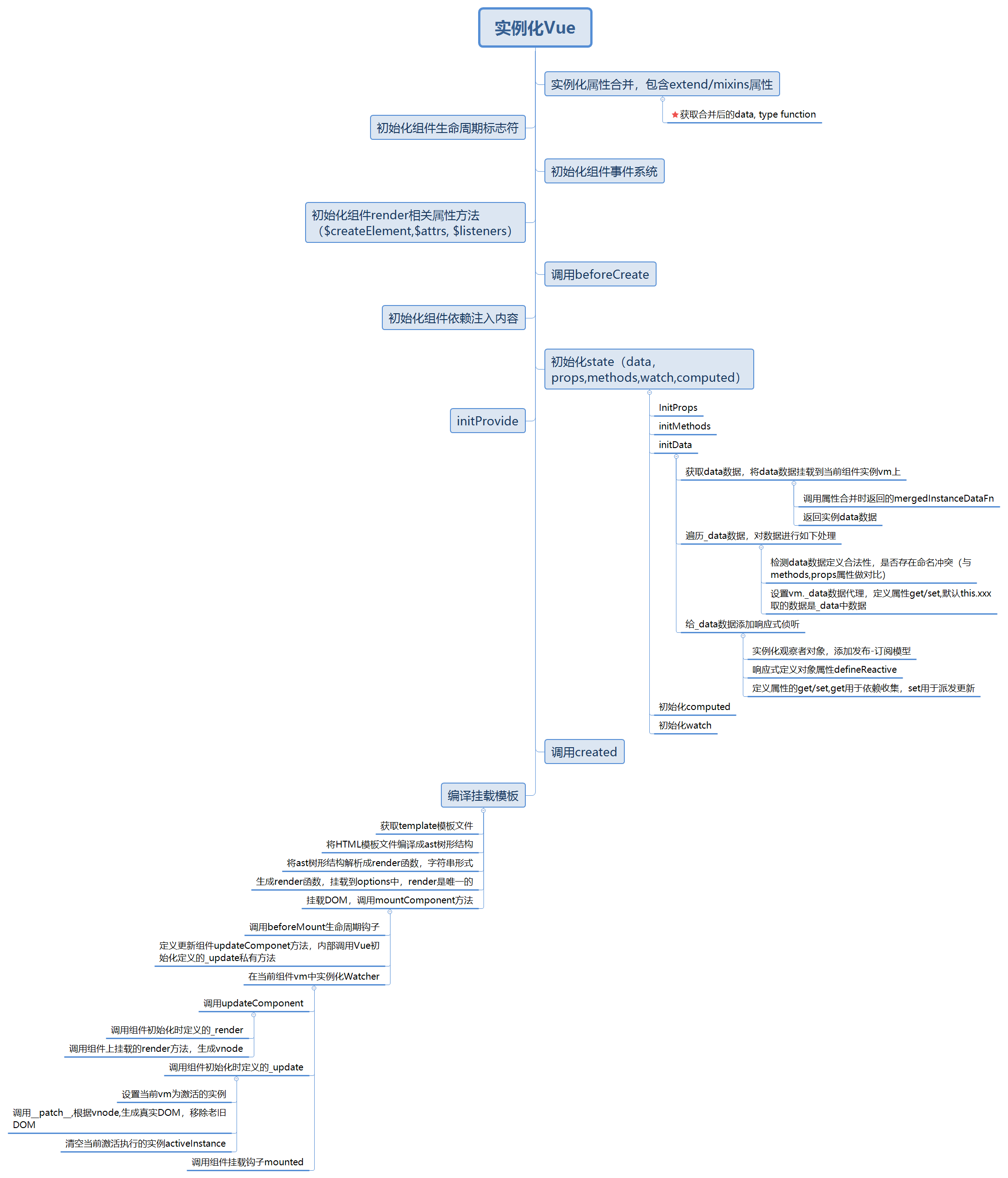
在vue源码中,vue构造函数的定义是在/src/core/instance下,入口文件index.js中,定义了Vue的构造方法,具体代码如下所示:
function Vue (options) { if (process.env.NODE_ENV !== 'production' && !(this instanceof Vue) ) { warn('Vue is a constructor and should be called with the `new` keyword') } this._init(options) }
Vue的构造方法接收一个参数options,options即我们实例化时定义的包含el,data,components等属性的对象,实例化时实际只执行vue初始化时已经在构造方法原型上定义的_init方法,_init实际代码如下所示:
Vue.prototype._init = function (options?: Object) { const vm: Component = this // a uid vm._uid = uid++ let startTag, endTag /* istanbul ignore if */ if (process.env.NODE_ENV !== 'production' && config.performance && mark) { startTag = `vue-perf-start:${vm._uid}` endTag = `vue-perf-end:${vm._uid}` mark(startTag) } // a flag to avoid this being observed vm._isVue = true // merge options // 合并属性,判断初始化的是否是组件 if (options && options._isComponent) { // optimize internal component instantiation // since dynamic options merging is pretty slow, and none of the // internal component options needs special treatment. initInternalComponent(vm, options) } else { // 合并vue属性 vm.$options = mergeOptions( resolveConstructorOptions(vm.constructor), options || {}, vm ) } /* istanbul ignore else */ if (process.env.NODE_ENV !== 'production') { // 初始化proxy拦截器 initProxy(vm) } else { vm._renderProxy = vm } // expose real self vm._self = vm // 初始化组件生命周期标志位 initLifecycle(vm) // 初始化组件事件侦听 initEvents(vm) // 初始化渲染方法 initRender(vm) callHook(vm, 'beforeCreate') // 初始化依赖注入内容,在初始化data、props之前 initInjections(vm) // resolve injections before data/props // 初始化props/data/method/watch/methods initState(vm) initProvide(vm) // resolve provide after data/props callHook(vm, 'created') /* istanbul ignore if */ if (process.env.NODE_ENV !== 'production' && config.performance && mark) { vm._name = formatComponentName(vm, false) mark(endTag) measure(`vue ${vm._name} init`, startTag, endTag) } // 挂载元素 if (vm.$options.el) { vm.$mount(vm.$options.el) } }
从上述代码中,我们可以清晰的看到在vue的生命周期每个阶段具体做了什么事,比如:
- 我们在beforeCreate中,是访问不到data数据的,mergeOptions是合并实例和mixins/extend上的数据,返回值vm.$options是合并后实例上的属性,data数据返回是一个function,因为属性data的合并策略是返回一个function,博文【浅析vue混入(mixins)】有具体的介绍。
- 在created时,我们并不能访问DOM对象,因为此时模板文件还没有解析,还没有生成具体的DOM元素,在created之前,只是对组件中的数据进行了初始化,具体的解析template和生成vnode,到生成真实DOM挂载到页面上,在vm.$mount方法中一步步执行。
用过vue的都知道,vue是数据驱动的一个框架,实现双向数据绑定是利用数据劫持,即Object.defineProperty的get和set,在get中进行依赖收集,set中进行派发更新。但是数据是如何初始化的呢?以data为例,我们来看下vue是如何进行数据初始化的。
如上述代码,在beforeCreate后,会走进initState方法,initState中,会分别对props,methods,data和watch进行初始化,如下所示:
export function initState (vm: Component) { // 初始化组件的watcher列表 vm._watchers = [] const opts = vm.$options if (opts.props) initProps(vm, opts.props) if (opts.methods) initMethods(vm, opts.methods) if (opts.data) { // 初始化data initData(vm) } else { observe(vm._data = {}, true /* asRootData */) } if (opts.computed) initComputed(vm, opts.computed) if (opts.watch && opts.watch !== nativeWatch) { initWatch(vm, opts.watch) } }
我们暂且值看initData,data在mergeOptions时,返回的是一个function,获取data数据,需要执行mergeOptions返回数据中的data方法,initData代码如下所示:
function initData (vm: Component) { let data = vm.$options.data // 获取到组件上的data data = vm._data = typeof data === 'function' ? getData(data, vm) : data || {} if (!isPlainObject(data)) { data = {} process.env.NODE_ENV !== 'production' && warn( 'data functions should return an object:\n' + 'https://vuejs.org/v2/guide/components.html#data-Must-Be-a-Function', vm ) } // proxy data on instance const keys = Object.keys(data) const props = vm.$options.props const methods = vm.$options.methods let i = keys.length while (i--) { const key = keys[i] if (process.env.NODE_ENV !== 'production') { // 属性名不能与方法名重复 if (methods && hasOwn(methods, key)) { warn( `Method "${key}" has already been defined as a data property.`, vm ) } } // 属性名不能与state名称重复 if (props && hasOwn(props, key)) { process.env.NODE_ENV !== 'production' && warn( `The data property "${key}" is already declared as a prop. ` + `Use prop default value instead.`, vm ) } else if (!isReserved(key)) { // 验证key值的合法性 // 将_data中的数据挂载到组件vm上,这样就可以通过this.xxx访问到组件上的数据 proxy(vm, `_data`, key) } } // observe data // 响应式监听data是数据的变化 observe(data, true /* asRootData */) }
getData代码如下所示:
export function getData (data: Function, vm: Component): any { // #7573 disable dep collection when invoking data getters pushTarget() try { // 调用在属性合并时,返回的data return data.call(vm, vm) } catch (e) { handleError(e, vm, `data()`) return {} } finally { popTarget() } }
这里面有pushTarget/popTarget,这里主要是用于保证无论何时,执行的组件监听计算只有一个,这个具体后面再讨论。getData的返回值就是合并后的data对象,赋值到当前的实例属性。接下来有个while循环,里面主要做三件事,
第一,判断我们声明的data变量的合法性,我们声明变量的名称一定不要与methods或者props中的属性名重复,这也是许多新手容易犯的错误
第二,声明变量的时候,不要用以_或者$开头的变量,这些可能会导致声明变量和vue私有变量冲突
第三,将data中的变量代理到vm(组件实例)上,按照this的指向性原理,data对象中的this应该指向data,而不应该指向vm,这里做了一层封装代理,具体代码如下:
// 属性代理,从一个原对象中拿数据 export function proxy (target: Object, sourceKey: string, key: string) { // 设置对象属性的get/set,将data中的数据代理到组件对象vm上 sharedPropertyDefinition.get = function proxyGetter () { return this[sourceKey][key] } sharedPropertyDefinition.set = function proxySetter (val) { this[sourceKey][key] = val } Object.defineProperty(target, key, sharedPropertyDefinition) }
接下来下一步所需要执行的内容就比较重要了,需要对data对象添加响应式侦听,调用observe方法,observe方法代码如下所示:
export function observe (value: any, asRootData: ?boolean): Observer | void { if (!isObject(value) || value instanceof VNode) { return } let ob: Observer | void // 存在__ob__属性的一般为观察者对象的实例 if (hasOwn(value, '__ob__') && value.__ob__ instanceof Observer) { ob = value.__ob__ } else if ( // Object.isExtensible 判断对象是否是可扩展的(可以添加新属性) shouldObserve && !isServerRendering() && (Array.isArray(value) || isPlainObject(value)) && Object.isExtensible(value) && !value._isVue ) { // 必须为数组 || 对象,才能实例化观察者对象 ob = new Observer(value) } if (asRootData && ob) { ob.vmCount++ } return ob }
每一个响应式对象,都会有__ob__属性,这个是vue中在声明响应式属性时定义的,如果没有该属性,数据的变化就不会被监测到,其他的可以暂时忽略,初始化响应对象是实例化了Observe类,Observer类的具体实现如下所示:
export class Observer { value: any; dep: Dep; vmCount: number; // number of vms that have this object as root $data constructor (value: any) { this.value = value // 实例化一个发布-订阅模型 this.dep = new Dep() this.vmCount = 0 // 给监听对象定义一个__ob__属性,属性值为this,指向当前实例 // 存在该属性的对象,就是响应式对象 def(value, '__ob__', this) // 数组类型 if (Array.isArray(value)) { // 存在原型 __proto__,重写数组原型上的方法 if (hasProto) { protoAugment(value, arrayMethods) } else { // 不存在原型,则在数组中复制重写后的数组方法 copyAugment(value, arrayMethods, arrayKeys) } // 响应式监听数组的变化 this.observeArray(value) } else { // 如果值的类型为Object,则响应式的声明对象属性 this.walk(value) } }
在实例化时,有两个分支,一个是数组,一个是对象,在实例化时,都会数据的中定义__ob__属性,值为当前观察者对象。我们先看对象的响应式声明方式,调用this.walk,具体代码如下:
walk (obj: Object) { const keys = Object.keys(obj) for (let i = 0; i < keys.length; i++) { // 响应式定义对象属性的get set defineReactive(obj, keys[i]) } }
defineReactive是重点,添加对象属性的get/set,get和set中进行数据的劫持,实现代码如下:
export function defineReactive ( obj: Object, key: string, val: any, customSetter?: ?Function, shallow?: boolean ) { // 初始化一个发布-订阅模型,每个对象都包含一个dep实例 const dep = new Dep() // 获取属性描述符 const property = Object.getOwnPropertyDescriptor(obj, key) // 对象的属性应该是可扩展、可配置的 if (property && property.configurable === false) { return } // cater for pre-defined getter/setters const getter = property && property.get const setter = property && property.set // 处理obj的值 if ((!getter || setter) && arguments.length === 2) { val = obj[key] } // 如果val值存在Object,则需要侦听val值的变化 let childOb = !shallow && observe(val) Object.defineProperty(obj, key, { enumerable: true, configurable: true, get: function reactiveGetter () { const value = getter ? getter.call(obj) : val // 依赖收集 @todo if (Dep.target) { dep.depend() if (childOb) { childOb.dep.depend() if (Array.isArray(value)) { dependArray(value) } } } return value }, set: function reactiveSetter (newVal) { // 派发更新 @todo // 获取到value数据 const value = getter ? getter.call(obj) : val /* eslint-disable no-self-compare */ if (newVal === value || (newVal !== newVal && value !== value)) { return } /* eslint-enable no-self-compare */ if (process.env.NODE_ENV !== 'production' && customSetter) { customSetter() } // #7981: for accessor properties without setter if (getter && !setter) return if (setter) { setter.call(obj, newVal) } else { val = newVal } // 重新更新下数据依赖 childOb = !shallow && observe(newVal) // 通知数据更新???@todo dep.notify() } }) }
任何数据的读取,都会走到get方法中,数据的更新,都会走get/set,其中在set中,dep.notify会派发更新页面数据,具体实现技术细节,在后续文章中,会进行详细描述。至此,data初始化工作算是完成了,数据的响应式原理核心利用Dep和Watcher两个类,后面文章专门详细描述vue的响应式原理及Dep和Watcher对象充当的角色和作用,本篇不做详细描述。
数据初始化完成后,接下来需要做的就是解析template和挂载dom,在src\platforms\web\entry-runtime-with-compiler.js中,定义了$mount方法,具体如下所示:
Vue.prototype.$mount = function ( el?: string | Element, hydrating?: boolean ): Component { // 获取或查询元素 el = el && query(el) /* istanbul ignore if */ // vue 不允许直接挂载到body或页面文档上 if (el === document.body || el === document.documentElement) { process.env.NODE_ENV !== 'production' && warn( `Do not mount Vue to <html> or <body> - mount to normal elements instead.` ) return this } const options = this.$options // resolve template/el and convert to render function if (!options.render) { let template = options.template // 存在template模板,解析vue模板文件 if (template) { if (typeof template === 'string') { if (template.charAt(0) === '#') { template = idToTemplate(template) /* istanbul ignore if */ if (process.env.NODE_ENV !== 'production' && !template) { warn( `Template element not found or is empty: ${options.template}`, this ) } } } else if (template.nodeType) { template = template.innerHTML } else { if (process.env.NODE_ENV !== 'production') { warn('invalid template option:' + template, this) } return this } } else if (el) { // 通过选择器获取元素内容 template = getOuterHTML(el) } if (template) { /* istanbul ignore if */ if (process.env.NODE_ENV !== 'production' && config.performance && mark) { mark('compile') } /** * 1.将temmplate解析ast tree * 2.将ast tree转换成render语法字符串 * 3.生成render方法 */ const { render, staticRenderFns } = compileToFunctions(template, { outputSourceRange: process.env.NODE_ENV !== 'production', shouldDecodeNewlines, shouldDecodeNewlinesForHref, delimiters: options.delimiters, comments: options.comments }, this) options.render = render options.staticRenderFns = staticRenderFns /* istanbul ignore if */ if (process.env.NODE_ENV !== 'production' && config.performance && mark) { mark('compile end') measure(`vue ${this._name} compile`, 'compile', 'compile end') } } } return mount.call(this, el, hydrating) }
从上述方法中,我们能得到以下信息:
1、不要将根元素放到body或者html上
2、在vue中,可以在对象中定义template/render或者直接使用template、el表示元素选择器,用法比较灵活
3、无论哪种写法,最终都会解析成render函数,调用compileToFunctions,会将template解析成render函数
对template的解析步骤大致分为以下几步:
1、将html文档片段解析成ast描述符
2、将ast描述符解析成字符串
3、生成render function
如下图所示:
template:

ast: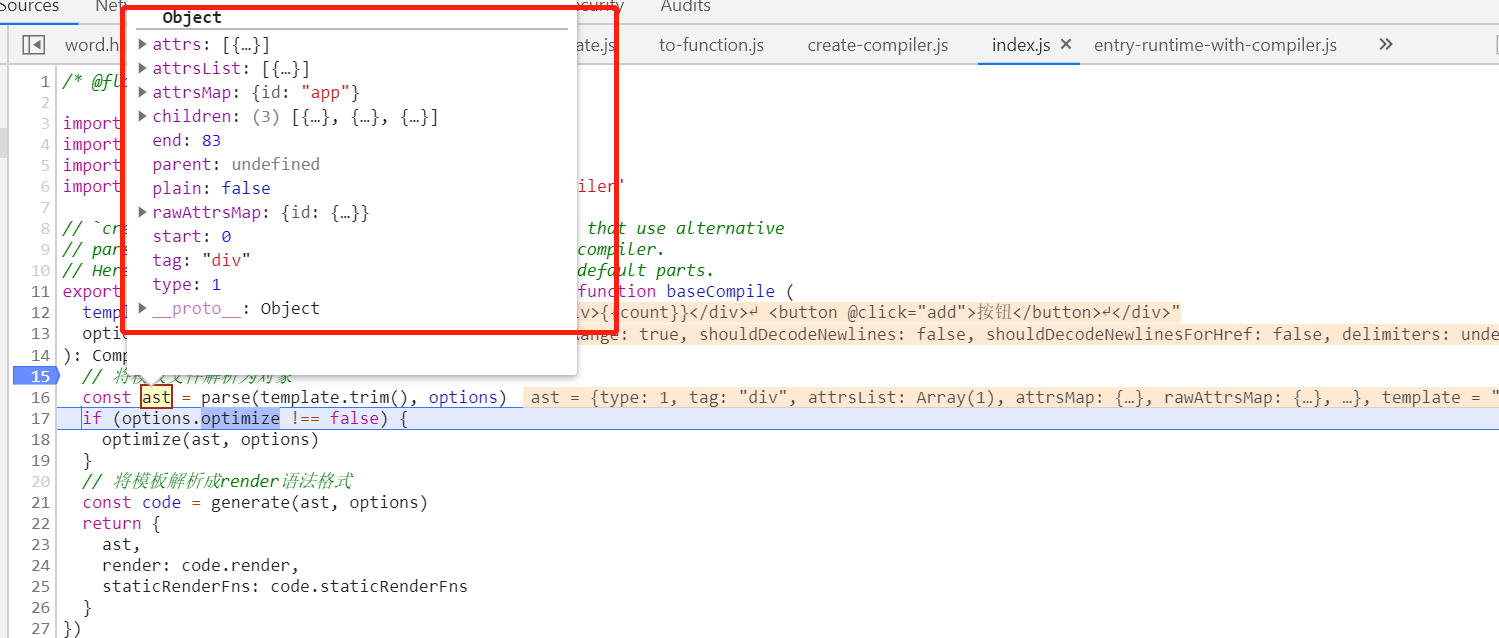
function string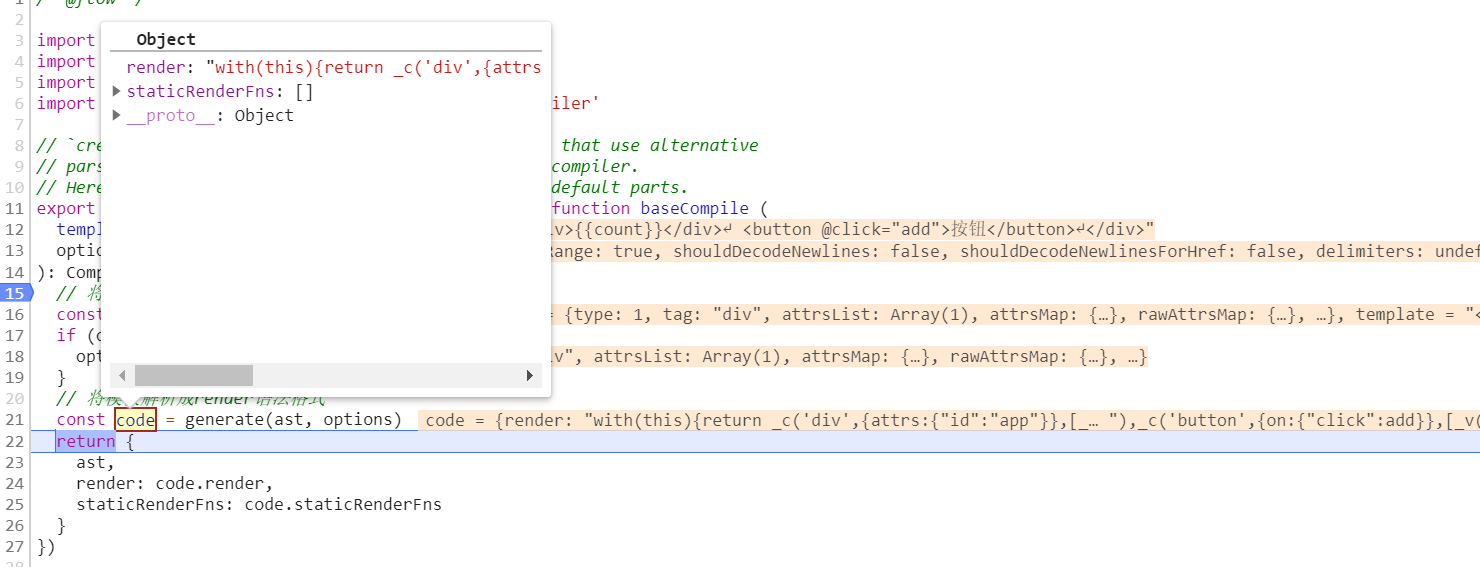
生成render函数:
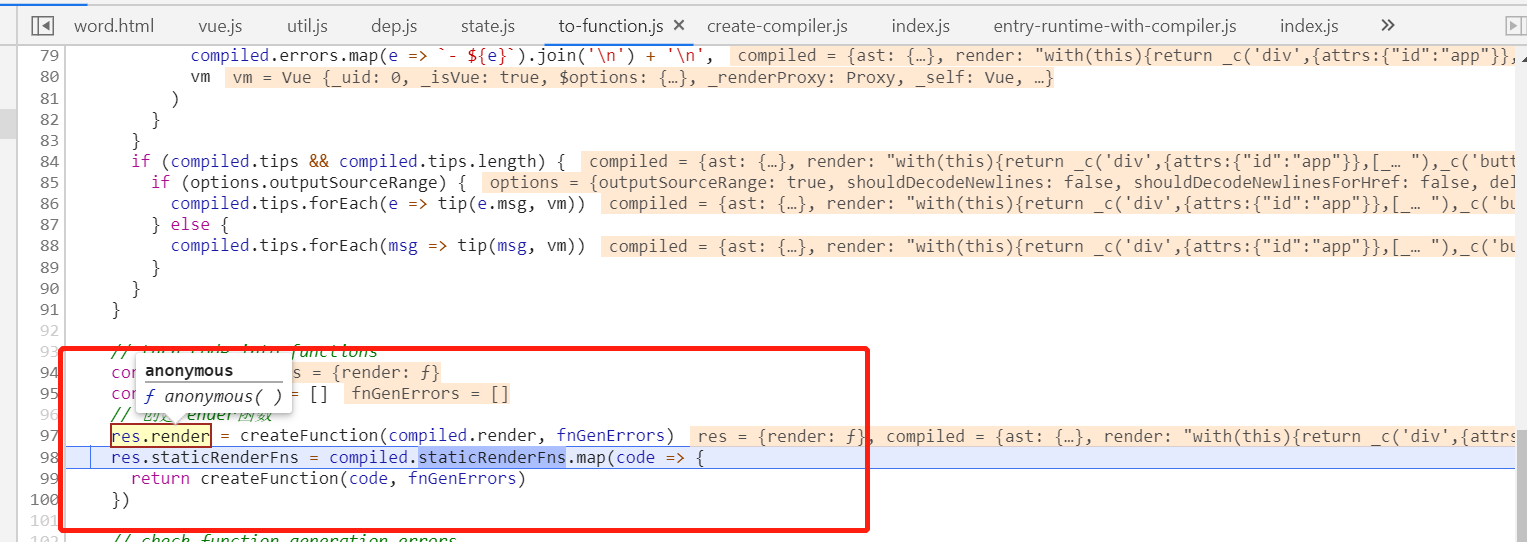
生成render函数,挂载到vm上后,会再次调用mount方法,这个mount方法不是entry-runtime-with-compiler.js复写的这个,是Vue原型上的方法在src\platforms\web\runtime\index.js中,里面会调用mountComponent方法,具体如下:
// public mount method Vue.prototype.$mount = function ( el?: string | Element, hydrating?: boolean ): Component { el = el && inBrowser ? query(el) : undefined // 渲染组件 return mountComponent(this, el, hydrating) }
src\core\instance\lifecycle.js
export function mountComponent ( vm: Component, el: ?Element, hydrating?: boolean ): Component { vm.$el = el // 如果没有获取解析的render函数,则会抛出警告 // render是解析模板文件生成的 if (!vm.$options.render) { vm.$options.render = createEmptyVNode if (process.env.NODE_ENV !== 'production') { /* istanbul ignore if */ if ((vm.$options.template && vm.$options.template.charAt(0) !== '#') || vm.$options.el || el) { warn( 'You are using the runtime-only build of Vue where the template ' + 'compiler is not available. Either pre-compile the templates into ' + 'render functions, or use the compiler-included build.', vm ) } else { // 没有获取到vue的模板文件 warn( 'Failed to mount component: template or render function not defined.', vm ) } } } // 执行beforeMount钩子 callHook(vm, 'beforeMount') let updateComponent /* istanbul ignore if */ if (process.env.NODE_ENV !== 'production' && config.performance && mark) { updateComponent = () => { const name = vm._name const id = vm._uid const startTag = `vue-perf-start:${id}` const endTag = `vue-perf-end:${id}` mark(startTag) const vnode = vm._render() mark(endTag) measure(`vue ${name} render`, startTag, endTag) mark(startTag) vm._update(vnode, hydrating) mark(endTag) measure(`vue ${name} patch`, startTag, endTag) } } else { updateComponent = () => { vm._update(vm._render(), hydrating) } } // we set this to vm._watcher inside the watcher's constructor // since the watcher's initial patch may call $forceUpdate (e.g. inside child // component's mounted hook), which relies on vm._watcher being already defined // 监听当前组件状态,当有数据变化时,更新组件 new Watcher(vm, updateComponent, noop, { before () { if (vm._isMounted && !vm._isDestroyed) { // 数据更新引发的组件更新 callHook(vm, 'beforeUpdate') } } }, true /* isRenderWatcher */) hydrating = false // manually mounted instance, call mounted on self // mounted is called for render-created child components in its inserted hook if (vm.$vnode == null) { vm._isMounted = true callHook(vm, 'mounted') } return vm }
这个方法中主要流程是:
1、调用了beforeMount钩子函数
2、定义updateComponent方法,是渲染DOM的入口方法
3、对vm添加监听,实例化一个watcher,然后调用updateComponent方法
4、调用mounted声明周期钩子,至此组件实例化结束
Watcher类如下所示:
export default class Watcher { vm: Component; expression: string; cb: Function; id: number; deep: boolean; user: boolean; lazy: boolean; sync: boolean; dirty: boolean; active: boolean; deps: Array<Dep>; newDeps: Array<Dep>; depIds: SimpleSet; newDepIds: SimpleSet; before: ?Function; getter: Function; value: any; constructor ( vm: Component, expOrFn: string | Function, cb: Function, options?: ?Object, isRenderWatcher?: boolean ) { this.vm = vm // 是渲染的watcher @todo if (isRenderWatcher) { vm._watcher = this } // 将vm添加到组件的_watchers队列中 vm._watchers.push(this) // options if (options) { this.deep = !!options.deep this.user = !!options.user this.lazy = !!options.lazy this.sync = !!options.sync this.before = options.before } else { this.deep = this.user = this.lazy = this.sync = false } this.cb = cb this.id = ++uid // uid for batching this.active = true this.dirty = this.lazy // for lazy watchers this.deps = [] this.newDeps = [] this.depIds = new Set() this.newDepIds = new Set() // updateComponents this.expression = process.env.NODE_ENV !== 'production' ? expOrFn.toString() : '' // parse expression for getter if (typeof expOrFn === 'function') { this.getter = expOrFn } else { this.getter = parsePath(expOrFn) if (!this.getter) { this.getter = noop process.env.NODE_ENV !== 'production' && warn( `Failed watching path: "${expOrFn}" ` + 'Watcher only accepts simple dot-delimited paths. ' + 'For full control, use a function instead.', vm ) } } this.value = this.lazy ? undefined : this.get() } /** * Evaluate the getter, and re-collect dependencies. * 执行更新组件的方法,先将当前要执行的watcher推入到执行队列中 @todo */ get () { pushTarget(this) let value const vm = this.vm try { value = this.getter.call(vm, vm) } catch (e) { if (this.user) { handleError(e, vm, `getter for watcher "${this.expression}"`) } else { throw e } } finally { // "touch" every property so they are all tracked as // dependencies for deep watching if (this.deep) { traverse(value) } popTarget() this.cleanupDeps() } return value }
看起来很长,其实主要就是调用在上述第二步声明的updateComponent方法,updateComponent方法主要执行在vue初始化时声明的_render,_update方法,其中,_render的作用主要是生成vnode,_update主要功能是调用__patch__,将vnode转换为真实DOM,并且更新到页面中,具体如下:
// 定义vue 原型上的render方法 Vue.prototype._render = function (): VNode { const vm: Component = this // render函数来自于组件的option const { render, _parentVnode } = vm.$options if (_parentVnode) { vm.$scopedSlots = normalizeScopedSlots( _parentVnode.data.scopedSlots, vm.$slots, vm.$scopedSlots ) } // set parent vnode. this allows render functions to have access // to the data on the placeholder node. vm.$vnode = _parentVnode // render self let vnode try { // There's no need to maintain a stack because all render fns are called // separately from one another. Nested component's render fns are called // when parent component is patched. currentRenderingInstance = vm // 调用render方法,自己的独特的render方法, 传入createElement参数,生成vNode vnode = render.call(vm._renderProxy, vm.$createElement) } catch (e) { handleError(e, vm, `render`) // return error render result, // or previous vnode to prevent render error causing blank component /* istanbul ignore else */ if (process.env.NODE_ENV !== 'production' && vm.$options.renderError) { try { vnode = vm.$options.renderError.call(vm._renderProxy, vm.$createElement, e) } catch (e) { handleError(e, vm, `renderError`) vnode = vm._vnode } } else { vnode = vm._vnode } } finally { currentRenderingInstance = null } // if the returned array contains only a single node, allow it if (Array.isArray(vnode) && vnode.length === 1) { vnode = vnode[0] } // return empty vnode in case the render function errored out if (!(vnode instanceof VNode)) { if (process.env.NODE_ENV !== 'production' && Array.isArray(vnode)) { warn( 'Multiple root nodes returned from render function. Render function ' + 'should return a single root node.', vm ) } vnode = createEmptyVNode() } // set parent vnode.parent = _parentVnode return vnode }
_render返回值: 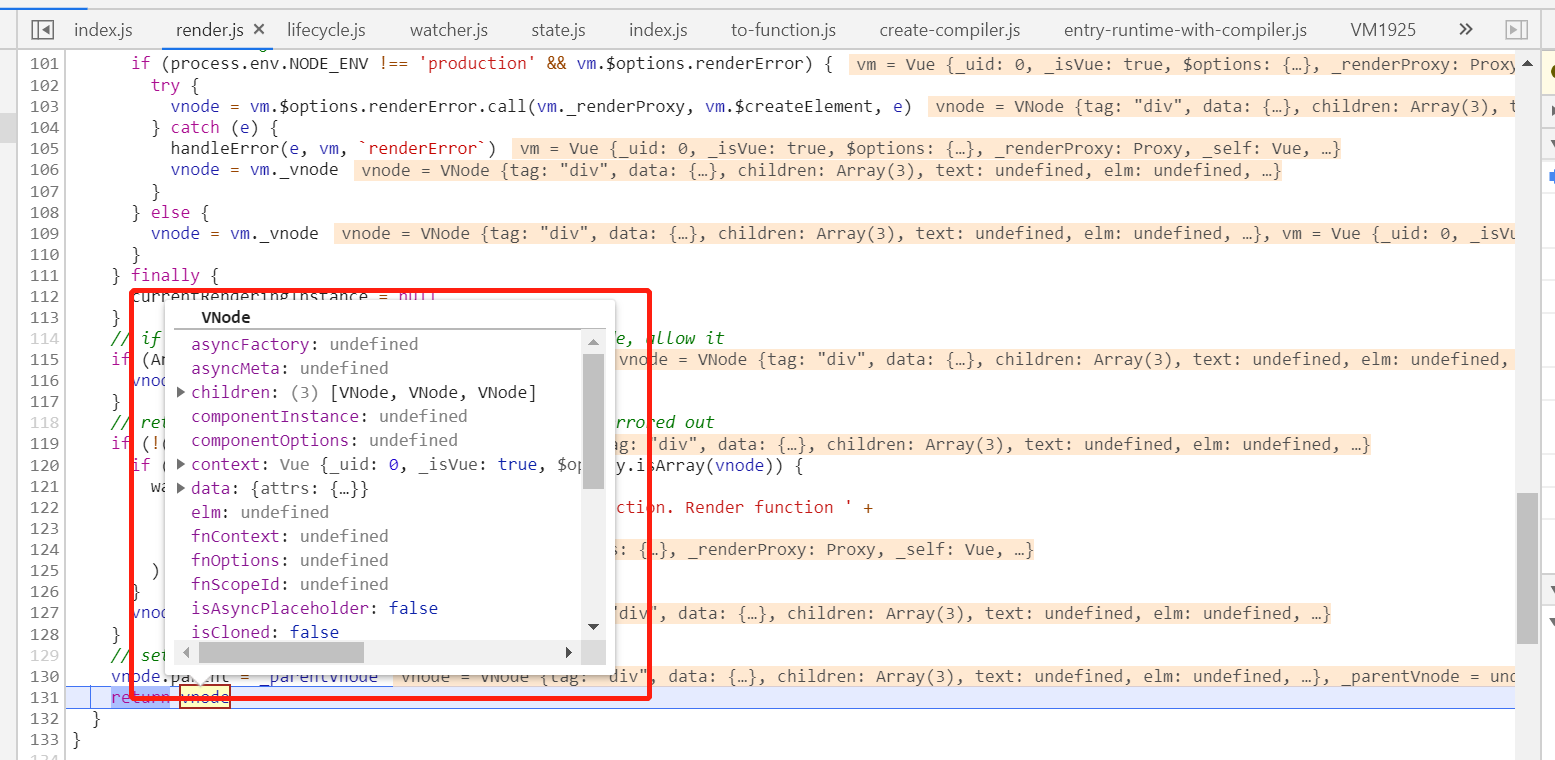
_update:
Vue.prototype._update = function (vnode: VNode, hydrating?: boolean) { const vm: Component = this const prevEl = vm.$el const prevVnode = vm._vnode // 设置当前激活的作用域 const restoreActiveInstance = setActiveInstance(vm) vm._vnode = vnode // Vue.prototype.__patch__ is injected in entry points // based on the rendering backend used. if (!prevVnode) { // initial render // 执行具体的挂载逻辑 vm.$el = vm.__patch__(vm.$el, vnode, hydrating, false /* removeOnly */) } else { // updates vm.$el = vm.__patch__(prevVnode, vnode) } restoreActiveInstance() // update __vue__ reference if (prevEl) { prevEl.__vue__ = null } if (vm.$el) { vm.$el.__vue__ = vm } // if parent is an HOC, update its $el as well if (vm.$vnode && vm.$parent && vm.$vnode === vm.$parent._vnode) { vm.$parent.$el = vm.$el } // updated hook is called by the scheduler to ensure that children are // updated in a parent's updated hook. }
在挂载DOM的过程中,是先添加新数据生成的节点,然后再移除老的节点。